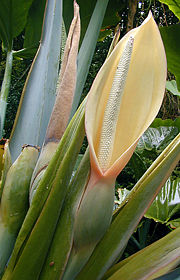Araceae
| Arum family Fossil range: 70–0 Ma Late Cretaceous[1] - Recent |
||||||||||
|---|---|---|---|---|---|---|---|---|---|---|
 Flower of Xanthosoma roseum
|
||||||||||
| Scientific classification | ||||||||||
|
||||||||||
| Genera | ||||||||||
|
See text. |
The arums comprise the Family Araceae (including the numerous aroids subfamily): monocotyledonous flowering plants in which flowers are borne on a type of inflorescence called a spadix. The spadix is usually accompanied by, and sometimes partially enclosed in, a spathe or leaf-like hood. This family of 107 genera and over 3700 species is most diverse in the New World tropics, although also distributed in the Old World tropics and north temperate regions. Recent genetic research by the Angiosperm Phylogeny Group has shown that the duckweeds, previously treated in a separate family Lemnaceae, also belong in the Araceae.
In monoecious aroids (possessing separate male and female flowers, but with both flowers present on one plant), the spadix is usually organized with female flowers towards the bottom and male flowers towards the top. In aroids with perfect flowers the stigma is no longer receptive when the pollen is released, thus preventing self-fertilization. There are also some dioecious species.
Anthurium and Zantedeschia are two well-known members of this family, as are Colocasia esculenta (taro) and Xanthosoma roseum (Elephant ear or ‘ape). Among the largest inflorescence in the world is that of the arum, Amorphophallus titanum (Titan arum). This family includes a great many ornamental plants: Dieffenbachia, Aglaonema, Caladium, Nephthys, and Epipremnum, to name a few. In the genus Cryptocoryne are many popular aquarium plants. Both Taro and Monstera deliciosa provide food value (the fruit of Monstera deliciosa called "Mexican breadfruit"). Philodendron is an important plant in the ecosystems of the rainforests and is often used in home and interior decorating. Symplocarpus foetidus (skunk cabbage) is a common North American species. A interesting peculiarity is that this family includes the largest unbranched inflorescence, that of the titan arum, often erroneously called the "largest flower" and the smallest flowering plant and smallest fruit, found in the duckweed, Wolffia.
Many plants in this family are thermogenic (heat-producing). Their flowers can reach up to 45 degrees Celsius even when the surrounding air temperature is much lower. One reason for this unusually high temperature is to attract insects (usually beetles) to pollinate the plant, rewarding the beetles with heat energy. Another reason is to prevent tissue damage in cold regions. Some examples of thermogenic Araceae are: Symplocarpus foetidus (eastern skunk cabbage), Amorphophallus titanum (Titan Arum), Amorphophallus paeoniifolius (elephant foot yam), Helicodiceros muscivorus (dead horse arum lily) and Sauromatum venosum (voodoo lily). Species such as Titan Arum and the dead horse arum give off a very pungent smell, often resembling a rotten animal. This is to attract flies to pollinate the plant. The heat produced by the plant helps to convey the scent further.
The largest collection of living Araceae is maintained at Missouri Botanical Gardens.[2] Another large collection of living Araceae can be found at Munich Botanical Garden, thanks to the efforts of the researcher and aroid authority Josef Bogner.

Contents |
Genera
Subfamily Aroideae
|
|
Subfamily Calloideae
- Calla L.
Subfamily Gymnostachydoideae
- Gymnostachys R. Br.
Subfamily Lasioideae
- Anaphyllopsis A. Hay
- Anaphyllum Schott
- Cyrtosperma Griff.
- Dracontioides Engl.
- Dracontium L.
- Lasia Lour.
- Lasimorpha Schott
- Podolasia N. E. Br.
- Pycnospatha Thorel ex Gagnep.
- Urospatha Schott
Subfamily Lemnaoideae
- Landoltia
- Lemna
- Spirodela
- Wolffia
- Wolffiella
Subfamily Monsteroideae
- Alloschemone Schott
- Amydrium Schott
- Anadendrum Schott
- Epipremnum Schott
- Heteropsis Kunth
- Holochlamys Engl.
- Monstera Adans.
- Rhaphidophora Hassk.
- Rhodospatha Poepp.
- Scindapsus Schott
- Spathiphyllum Schott
- Stenospermation Schott
Subfamily Orontioideae
- Lysichiton Schott
- Orontium L.
- Symplocarpus Salisb. ex W. P. C.
Barton, nom. cons.
Subfamily Pothoideae
- Anthurium Schott
- Pedicellarum M. Hotta
- Pothoidium Schott
- Pothos L.
Subfamily Zamioculcadoideae
- Gonatopus Hook. f. ex Engl.
- Zamioculcas Schott
References
- ↑ Bogner, Josef; Johnson, Kirk R.; Kvacek, Zlatko; Upchurch, Garland R. Jr (2007). "New fossil leaves of Araceae from the Late Cretaceous and Paleogene of western North America". Zitteliana 47: 133-147.
- ↑ . "The resources which have been built up for aroid research at the Missouri Botanical Garden include one of the largest living collections of aroids and the largest collection of herbarium specimens of neotropical aroids. The living and dried collections include a large percentage of Croat's more than 80,000 personal collections". (Croat, Thomas B (1998). "History and Current Status of Systematic Research with Araceae". Aroideana 21.)
- Bown, Deni (2000). Aroids: Plants of the Arum Family [ILLUSTRATED]. Timber Press. ISBN 0881924857
- Keating R C (2004). "Vegetative anatomical data and its relationship to a revised classification of the genera of Araceae". Annals of the Missouri Botanical Garden 91 (3): 485–494.
- Croat, Thomas B (1998). "History and Current Status of Systematic Research with Araceae". Aroideana 21. on line